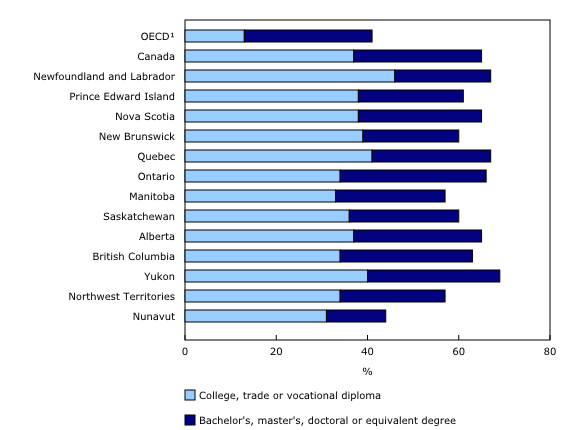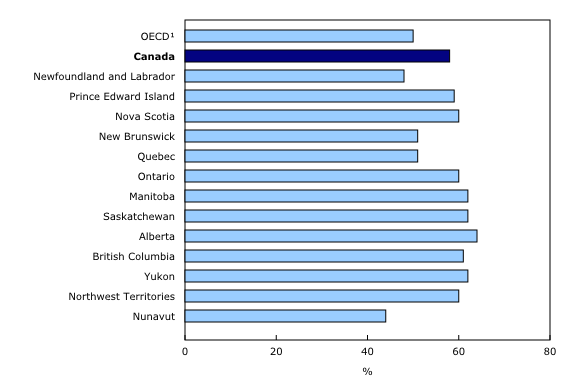Education indicators in Canada: An international perspective, 2017
Archived Content
Information identified as archived is provided for reference, research or recordkeeping purposes. It is not subject to the Government of Canada Web Standards and has not been altered or updated since it was archived. Please "contact us" to request a format other than those available.
Released: 2017-12-12
In 2016, 91% of Canadians aged 25 to 64 had at least a high school diploma or postsecondary credential, well above the Organisation of Economic Co-operation and Development (OECD) average of 78%. Only the Czech Republic (94%) and Poland (92%), posted higher proportions. The United States was comparable with Canada at 90%.
The proportion of Canadians aged 25 to 64 who had completed at least a high school diploma was also higher than the OECD average in every province and territory except Nunavut (61%). The proportion ranged from 83% in the Northwest Territories to 93% in British Columbia.
Just over two-thirds (68%) of Canadians aged 25 to 64 had completed postsecondary education in 2016, well above the OECD average of 42%, while 31% had a bachelor's degree or higher, in line with the OECD average of 29%. Those attaining other types of postsecondary education, including at the college, trade or vocational level, comprised 36% of Canadians aged 25 to 64. This is partly a reflection of Canada's extensive network of colleges, a system not seen in most other OECD countries, where the comparable average was 13%.
Higher levels of education are generally linked to improved employment prospects. In 2016, the Canadian employment rate for adults aged 25 to 64 who had not completed high school (upper secondary education) was 55%, below the OECD average of 58%. By comparison, the employment rate among individuals of the same age group was highest for those who had a college or university credential at 82%. This was slightly below the OECD average of 84%.
The resources devoted to education, as measured by the share of gross domestic product (GDP), varied across OECD countries. In 2014, Canada spent 6.0% of GDP on education compared with the OECD average of 5.2%. The share of GDP devoted to educational institutions varied within Canada, from 4.4% in Alberta (which had a relatively high GDP) to 8.8% in Nunavut.
In 2017, 12% of young Canadians aged 15 to 29 were not in education, employment or training (NEET). The OECD average was 14%. In comparison with other G7 countries, Canada had a similar proportion of NEET youth to the United Kingdom (13%) and the United States (14%), but a higher proportion than Germany and Japan (both at 10%).
In 2014/2015, among the 35 OECD countries, Canadian full-time teachers in lower secondary institutions (generally equivalent to Grades 7 to 9) with 15 years of experience had the fourth-highest salaries at US$65,621. They trailed Luxembourg (US$113,136), Germany (US$74,078) and the Netherlands (US$69,268). Within Canada, salaries for full-time teachers in lower secondary institutions with 15 years of experience ranged from US$57,158 in Quebec to US$81,741 in the Northwest Territories.
Teachers in Canada do, however, spend more time teaching on average than their OECD counterparts. While at the primary level, hours of teaching time were fairly comparable between the OECD (794) and Canada (797) in 2014/2015, differences were more pronounced at the secondary levels. At the lower secondary level, these figures were 742 hours per year in Canada compared with the OECD average of 712 hours, while at the upper secondary level (generally Grades 10 to 12), Canadian teachers taught an average of 743 hours compared with 662 hours for the OECD.
The participation rate of Canadians aged 25 to 64 in formal and/or non-formal education in 2012 was 58%, a rate higher than the OECD average 50%. Across the provinces and territories, participation rates ranged from 44% in Nunavut to 64% in Alberta. Participation rates decreased with age, with 25 to 34 year olds having the highest rates at 70%, and adults aged 55 to 64 having the lowest (41%). Notably, the participation rates for women (58%) and men (59%) were similar, although this changed with the presence of children. Participation rates of men with children were higher (65%) than participation rates of women with children (59%), while there was no difference between men and women without children (both 57%).
Among the provinces and territories, the most commonly cited barrier to participation in formal and/or non-formal education among those aged 25 to 64 was being too busy at work, ranging from 25% in Quebec to 37% in Prince Edward Island. The second most commonly cited barrier to participation was cost, ranging from 5% in Nunavut to 22% in British Columbia. Child care or family responsibilities was also cited as a barrier to participation in education and was most commonly cited in Quebec (21%) and British Colombia (18%). It was least reported in Prince Edward Island (8%), Newfoundland and Labrador (9%) and Yukon (9%).
Note to readers
The publication Education Indicators in Canada: An International Perspective, 2017, is the ninth in a series of reports designed to complement the Organisation for Economic Co-operation and Development's (OECD) annual report on education indicators, Education at a Glance: OECD Indicators.
The 12 indicators presented in this 2017 Canadian compendium represent a selection of indicators that were developed to align with the definitions and methodologies used by the OECD in its most recent report, Education at a Glance 2017: OECD Indicators. Data for Canada, the provinces and territories were drawn from several sources and various reference years, as required to provide comparisons with OECD figures.
The 2017 indicators for Canada, the provinces and territories capture information on educational attainment, graduation and completion rates at the secondary level, labour market outcomes, expenditures per student, expenditures on education, international students, transitions to the labour market, and the learning environment and organization of schools. It also features an indicator that presents a selection of topics related to a 2012 assessment of adult literacy and numeracy, released in Programme for the International Assessment of Adult Competencies (89-555-X).
The information contained in the report was prepared by the Canadian Education Statistics Council, a partnership between Statistics Canada and the Council of Ministers of Education, Canada. The report is part of the Pan-Canadian Education Indicators Program of Statistics Canada.
Data for the OECD member countries are from the OECD publication Education at a Glance 2017: OECD Indicators, available on the OECD website.
Products
The publication Education Indicators in Canada: An International Perspective, 2017 (81-604-X), is now available.
The public is also invited to chat with an expert on Friday, December 15, 2017, from 1:00 to 2:00 p.m., Eastern Time.
Contact information
For more information, or to enquire about the concepts, methods or data quality of this release, contact us (toll-free 1-800-263-1136; 514-283-8300; STATCAN.infostats-infostats.STATCAN@canada.ca) or Media Relations (613-951-4636; STATCAN.mediahotline-ligneinfomedias.STATCAN@canada.ca).
- Date modified:



